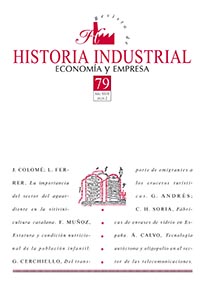Estatura y condición nutricional de la población infantil en una ciudad industrial española: el caso de Barcelona (1900-1969)
DOI:
https://doi.org/10.1344/rhi.v29i79.28782Paraules clau:
crecimiento infantil, bienestar biológico, industrialización, BarcelonaResum
Como consecuencia de un conjunto de reformas urbanas y sanitarias a partir de la segunda mitad del siglo XIX la mortalidad de Barcelona descendió. Los cambios biológicos en la población menor de 15 años son relevantes para explicarlo. Este artículo los analiza en base a estadísticas antropométricas publicadas. Se reconstruye la evolución secular de su crecimiento y se diagnostica su estado nutricional a lo largo de siete décadas del siglo XX. Los resultados muestran: a) Entre los nacidos antes de la Guerra Civil los incrementos medios de estatura (de 7 a 13 años) por decenio eran menores de un centímetro. Aquellos que lo hicieron a partir de los cincuenta superaron los dos centímetros. b) Los niveles de malnutrición fueron principalmente moderados (en torno al 20%) con una reducción significativa a partir la década de los cincuenta. c) Las diferencias de género, sociales y residenciales persistieron a lo largo de las siete décadas, aun participando toda la población infantil en el incremento general de las tallas en todas las edades.
Descàrregues
Descàrregues
Publicades
Com citar
Número
Secció
Llicència
The author assigns all rights to the publisher. Creative Commons
The author who publishes in this journal agrees to the following terms:
- The author assigns all intellectual property rights exclusively to the publisher for the entire duration of the applicable intellectual property rights.
- The publisher will distribute the texts under the Creative Commons Attribution License, which allows others to share the work, provided that they acknowledge the authorship, its initial publication in this journal, and the conditions of the license.





